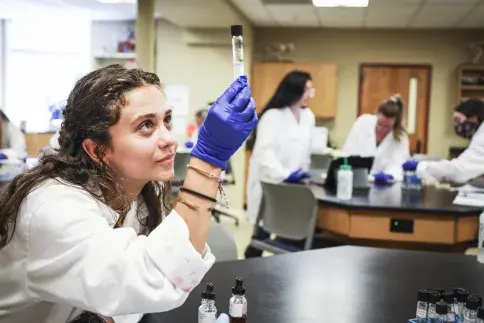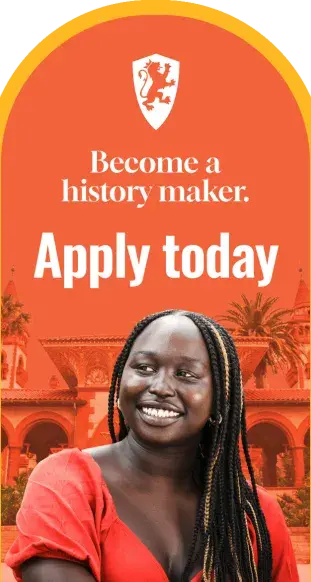Biology & Coastal Environmental Science FAQ

What types of careers can I get with a Biology or CES degree?
Types of careers
A Biology or CES degree sets graduates on paths that make an impact, working in healthcare and genetics labs, government agencies, conservation fields, and environmental advocacy. Alumni have gone on to organizations such as the Florida Fish and Wildlife Conservation Commission and the Army Corps of Engineers , and into roles at museums, aquariums, and zoos where science meets education.
Beyond specific jobs, the degree cultivates skills in research, policy making, data analysis, and problem-solving, tools that shape adaptable professionals. Whether in a lab, on the water, or influencing environmental policy, graduates carry forward the kind of preparation that changes futures.
What graduate school opportunities are available ?
Graduate school opportunities
Science majors from these programs have gone on to Marine Science at William & Mary, Biotechnology at Florida Tech, and Fisheries and Aquatic Science at the University of Florida, as well as Ph.D. programs in Biology and health professions like medicine, dentistry, and veterinary care. Read Carly’s story to see how undergraduate research and mentorship shaped her path to graduate school.
The thread tying these stories together is more than strong coursework, it’s the transformative experiences that come from doing real science. Students present at national and international conferences, collaborate with faculty mentors, and tell their research stories in ways that stand out to graduate programs. Additionally, our Career Development Center offers graduate school fairs each year. Curiosity here doesn’t stay in the classroom; it opens doors across the world.
Are there classes within the biology program that will help prepare me for healthcare careers?
Preparing for healthcare careers
The curriculum provides the essential courses for medical, veterinary, dental, and other health-related graduate programs. Students build a solid foundation in biology, chemistry, physics, genetics, and psychology, while working with advisors to tailor a plan that aligns with their career aspirations. Example classes include:
- General Biology I & II
- General Chemistry I & II
- Organic Chemistry I (currently available) & Organic Chemistry II (Start Date: Spring 2027)
- Physics I (currently available) & Physics II(Start Date: Spring 2027)
- Genetics
- Biochemistry
- Calculus & Statistics
- Psychology and Sociology
- Useful electives such as: Anatomy & Physiology I & II, Microbiology, Intro to Biotechnology, Animal Behavior
This approach allows students to prepare intentionally for the professional schools ahead, combining rigorous science with the personal support to turn ambition into action.
What types of research opportunities are available, and when can students begin?
Research opportunities
Students have monitored sea turtle populations on nearby beaches, mapped dolphins by boat in the Intracoastal, and analyzed the chemistry of marshes and estuaries. Others have studied fire ecology, bird behavior, or genetics, building their scientific voice through collaboration and presentation.
These opportunities help you hone skills, lab techniques, data analysis, field sampling, and critical thinking, while telling real scientific stories. Whether you start as early as your first semester or join a project later, your involvement helps you grow, connect with faculty, and build a foundation for graduate school or a career in research.
How are research opportunities arranged with professors?
How research opportunities are arranged
Most often, research begins with a conversation. Professors share opportunities when they need help on a project, but students also step forward—asking how they can be involved or suggesting new ideas. Faculty welcome this curiosity, turning student initiative into genuine collaboration.
How much course work takes place in St. Augustine’s intracoastal areas, and what are examples of fieldwork?
Where you will work
The coast itself becomes the classroom. Students study beach erosion and renourishment on local shores, board boats to track dolphins in their natural habitat, and collect samples in marshes and estuaries that define Northeast Florida’s landscape.
Fieldwork here transforms learning: theory meets tide, data meets salt air. These experiences give students not only a deeper understanding of science, but also a sense of connection to place and purpose that stays with them long after graduation.
What classes use the modular lab, and what makes it unique?
The modular lab
Chemistry and physics courses are taught in the modular lab, a state-of-the-art facility designed for advanced experiments and expanded offerings. Built with the systems needed for upper-level science, it allows students to conduct experiments safely and confidently.
For many, this is where science feels like it shifts into something bigger, where the skills of a research lab begin, and the confidence to pursue graduate-level work takes root.
Besides coursework and research, what else supports hands-on learning?
Other hands-on learning
The broader community extends learning beyond campus. Students work with the National Estuarine Research Reserve, Anastasia State Park, the Whitney Lab & Sea Turtle Hospital, and the Matanzas Riverkeeper, partners that turn curiosity into contribution.
Whether monitoring sea turtle health, studying estuarine ecosystems, or engaging in conservation, these collaborations reflect a hallmark of the program: a blend of location and transformative academics that makes the student experience distinct. Here, science is not only studied, it’s lived in the very environments that define it.
If you are curious about what this looks like, check out student, CJ Carter’s study abroad trip to Bermuda.
